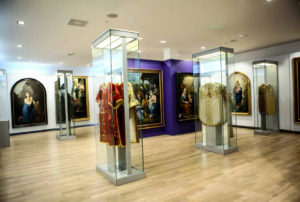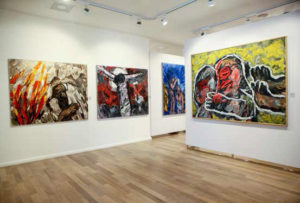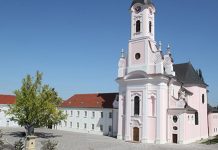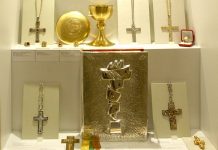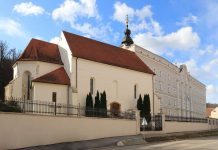From idea to realization
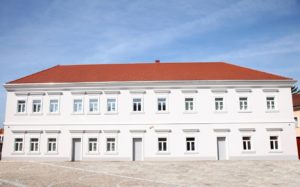 The book Diocesan Museum and Cathedral Treasury in Požega introduces institutions that have played an important role in fulfilling the mission of the Požega Bishopric. They preserve and largely exhibit objects that belong to the sacral legacy produced in the Požega Diocese, in parishes of western and central Slavonia, with some additions of modern and contemporary Croatian art.
The book Diocesan Museum and Cathedral Treasury in Požega introduces institutions that have played an important role in fulfilling the mission of the Požega Bishopric. They preserve and largely exhibit objects that belong to the sacral legacy produced in the Požega Diocese, in parishes of western and central Slavonia, with some additions of modern and contemporary Croatian art.
Pastoral Role of the Diocesan Museum and the Cathedral Treasury
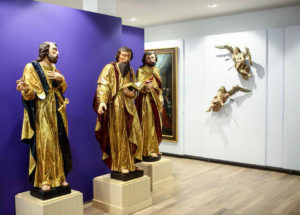 These institutions are rooted in the long and rich history of the Catholic Church, which has always assigned the central role to the divine service as the source and pinnacle of its life by acquiring objects needed for liturgical celebrations and by preferring those with artistic value. Cathedral treasuries through out the Catholic world have grown with centuries of collection activity. They preserve and maintain liturgical objects used in solemn episcopal celebrations in cathedral churches, deposited and exhibited in adequate space next to the cathedral, objects that testify of the life of a local church in its centre. This has been the model for establishing other diocesan museums as well, namely to collect and preserve primarily those liturgical objects from a particular diocese that are currently out of use, a principle that was particularly evident in the renovation of sacral space after Vaticanum II. The specificity of cathedral treasuries and diocesan museums is that they are not a result of museological activity in the Church, since that is not the aim of its mission; instead, they are pastoral institutions of individual bishoprics, in which their sacral legacy, collected from the cathedral or from parish churches and other institutions in that area, preserves a living memory of the past generations and shows the continuity of faith in the present community. These objects bear an imprinted faith of those who have produced them, believers that raised their souls towards God while creating them, becoming part of God’s world and partaking in the mysteries celebrated with these very objects, building their spiritual identity and leaving a permanent mark in their living environment.
These institutions are rooted in the long and rich history of the Catholic Church, which has always assigned the central role to the divine service as the source and pinnacle of its life by acquiring objects needed for liturgical celebrations and by preferring those with artistic value. Cathedral treasuries through out the Catholic world have grown with centuries of collection activity. They preserve and maintain liturgical objects used in solemn episcopal celebrations in cathedral churches, deposited and exhibited in adequate space next to the cathedral, objects that testify of the life of a local church in its centre. This has been the model for establishing other diocesan museums as well, namely to collect and preserve primarily those liturgical objects from a particular diocese that are currently out of use, a principle that was particularly evident in the renovation of sacral space after Vaticanum II. The specificity of cathedral treasuries and diocesan museums is that they are not a result of museological activity in the Church, since that is not the aim of its mission; instead, they are pastoral institutions of individual bishoprics, in which their sacral legacy, collected from the cathedral or from parish churches and other institutions in that area, preserves a living memory of the past generations and shows the continuity of faith in the present community. These objects bear an imprinted faith of those who have produced them, believers that raised their souls towards God while creating them, becoming part of God’s world and partaking in the mysteries celebrated with these very objects, building their spiritual identity and leaving a permanent mark in their living environment.
Therefore, these objects are not mere museum exhibits and cannot be reduced to their art-historical significance – they are precious, living witnesses of the continuity of Church in a community and the area where it is active, a source of inspiration in its current mission. Sometimes these objects are of minor artistic value, yet of great historical significance with regard to the life of believers that used them. This contextual evaluation of ecclesiastical cultural and historical heritage prevents it from being separated from its pastoral function when exhibited at the museum. Various ecclesiastical documents, issued by the Pope as well as on other levels including the legislative one, promote the preservation of sacral heritage primarily for these pastoral reasons, always keeping in mind that its artistic value serves the purpose of humanization and evangelization of all those who encounter them at the museum and that it is part of the culture as a whole in its environment. This is the main topic of the “Circular Letter on the Pastoral Function of Ecclesiastical Museums” issued by the Pontifical Commission for the Cultural Heritage of the Church (2001), a body in charge of these ecclesiastical questions, and its principles should also be included in the implementation of the “Contract between the Holy See and the Republic of Croatia on Cooperation in the Field of Education and Culture” (1996), which has recently been put to practice.
Preparations for the Foundation of the Diocesan Museum in Požega
The Požega Bishopric, aware of the significance of the Diocesan Museum as stated above, sought from its very beginnings to collect objects of sacral heritage that were out of liturgical use from its territories. This was particularly significant as various historical events caused major devastations in Slavonia, from the Ottoman rule to the recent Croatian Liberation War, in which most medieval witnesses of the life of the Church have been damaged or lost. The situation was, namely, quite different in some other regions of Croatia, which preserved a considerable number of sacral artefacts from the ancient past. In this episcopal enterprise, an additional motivation was the fact that in Croatia – in both the lay and the ecclesiastical sphere – cultural life has been reduced to a few major centres, whereby the stretch between Zagreb and Osijek leaves the impression of certain emptiness, which has also had consequences for the regional identity. Another powerful impetus came from the city of Požega: its unique preserved historical core, built during the late medieval period, contains two precious objects of immovable sacral heritage in its main square, both from the 13th century, which survived the Ottoman period: St Laurence’s church and the Franciscan church of the Holy Spirit.
This heritage was enriched with baroque sacral buildings after the decline of the Ottoman rule, including the Franciscan monastery and the Episcopal Centre built by the Jesuits in the early 18th century, which obtained its present appearance during the late 19th and early 20th centuries, with the monastery of the Sisters of Charity that was originally built as a Jesuit convent, and a votive pillar dedicated to the Holy Trinity (1749) as the central piece of the complex, which has given the square its name. In the continuation of this inherited complex, Franjo Thauszy, bishop of Zagreb, commissioned the construction of the church of St Theresa with the support of Empress Marian Theresa, creating a new square and enriching the immovable sacral heritage of Požega with one of the most magnificent late baroque buildings in Croatia from the second half of the 18th century: the building that Pope John Paul II raised to the honour of a cathedral in 1997, on the occasion of the foundation of the Požega Bishopric. Recently, its interior and exterior have been renovated, and a new bronze gate, work of sculptor Marija Ujević Galetović (2016), endows the church building and the square with great solemnity. The cathedral square also features a well integrated, recently built two-storey house of the Diocesan Museum, which creates the impression of architectural perfection and urbanist harmony in the square. Thus, the immovable sacral heritage of Požega has been merged into a single unit, with the movable heritage collected throughout the present-day Požega Diocese preserved in the churches and the Museum, elevating Požega to the status of a city that culturally unites central and western Slavonia as the diocesan territories.
Foundation of the Diocesan Museum in Požega
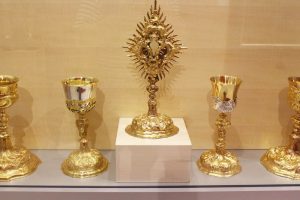 The Diocesan Museum was founded on April 7, 1999. Its aim and the initial situation was defined by a Decree, which states the following: “With its foundation and establishment in 1997, the Požega Bishopric took over the extensive sacral and cultural heritage collected over several centuries as an expression of faith in the people of God and the historical continuity of the Church in western and central Slavonia. There are many objects throughout the bishopric that are out of liturgical use and do not serve any sacral purpose, which means that they are in danger of being lost or damaged by age. That would mean an irreparable loss of those precious witnesses to the specificity of religious cultural expression of Croatian people living in this region. For this reason, I am hereby founding the Diocesan Museum of the Požega Bishopric with the task of collecting, preserving, and maintaining objects of sacral heritage in the area of the Požega Diocese. All objects that are located in the Diocesan Museum of the Požega Bishopric and originate from the parishes of the present-day Požega Diocese, and which have been documented in the inventory as property of these parishes, will be taken over by the Požega Bishopric and become property of its Diocesan Museum in accordance with the apostolic epistles of Pope John Paul II on the foundation of new bishoprics and an agreement between Archbishop Msgr. Josip Bozanić, Msgr. Antun Škvorčević, bishop of Požega, and Msgr. Marko Culej, bishop of Varaždin, signed at the metropolitan working session held in Požega on March 24, 1999. These objects will be carefully listed in the Museum’s inventory and adequately catalogued.” The Decree further states: “With the foundation of the Požega Bishopric, the Department of the Diocesan Museum of the Zagreb Archbishopric, active since July 26, 1974 in the parish of Velika near Požega, which has so far collected, maintained, and presented various objects of cultural heritage from the area of present-day Požega Diocese and the region of Požega, becomes property of the Požega Bishopric and part of its Diocesan Museum. A detailed list of objects will be made and added to the Museum’s inventory.”
The Diocesan Museum was founded on April 7, 1999. Its aim and the initial situation was defined by a Decree, which states the following: “With its foundation and establishment in 1997, the Požega Bishopric took over the extensive sacral and cultural heritage collected over several centuries as an expression of faith in the people of God and the historical continuity of the Church in western and central Slavonia. There are many objects throughout the bishopric that are out of liturgical use and do not serve any sacral purpose, which means that they are in danger of being lost or damaged by age. That would mean an irreparable loss of those precious witnesses to the specificity of religious cultural expression of Croatian people living in this region. For this reason, I am hereby founding the Diocesan Museum of the Požega Bishopric with the task of collecting, preserving, and maintaining objects of sacral heritage in the area of the Požega Diocese. All objects that are located in the Diocesan Museum of the Požega Bishopric and originate from the parishes of the present-day Požega Diocese, and which have been documented in the inventory as property of these parishes, will be taken over by the Požega Bishopric and become property of its Diocesan Museum in accordance with the apostolic epistles of Pope John Paul II on the foundation of new bishoprics and an agreement between Archbishop Msgr. Josip Bozanić, Msgr. Antun Škvorčević, bishop of Požega, and Msgr. Marko Culej, bishop of Varaždin, signed at the metropolitan working session held in Požega on March 24, 1999. These objects will be carefully listed in the Museum’s inventory and adequately catalogued.” The Decree further states: “With the foundation of the Požega Bishopric, the Department of the Diocesan Museum of the Zagreb Archbishopric, active since July 26, 1974 in the parish of Velika near Požega, which has so far collected, maintained, and presented various objects of cultural heritage from the area of present-day Požega Diocese and the region of Požega, becomes property of the Požega Bishopric and part of its Diocesan Museum. A detailed list of objects will be made and added to the Museum’s inventory.”
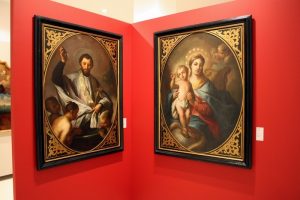 The Diocesan Museum in Požega consists of the Sacral Collection, Collection of Modern and Contemporary Art, Ethnographic Collection (largely compiled by Mirko Roginić, who was the parish priest of Velika for many years), Collection of Graphic Art, and Collection of Plaques. A permanent exhibition of the Sacral Collection and the Collection of Modern and Contemporary Art has been set up in the building of the Diocesan Museum at the cathedral square in Požega, and partly exhibited at the Episcopal Centre as a segment of the museum collection. Preparations for the permanent exhibition of the Ethnographic Collection near the parish church in Velika are currently underway, while the Collection of Graphic Art and the Collection of Plaques will remain in the studio archive of the Diocesan Museum.
The Diocesan Museum in Požega consists of the Sacral Collection, Collection of Modern and Contemporary Art, Ethnographic Collection (largely compiled by Mirko Roginić, who was the parish priest of Velika for many years), Collection of Graphic Art, and Collection of Plaques. A permanent exhibition of the Sacral Collection and the Collection of Modern and Contemporary Art has been set up in the building of the Diocesan Museum at the cathedral square in Požega, and partly exhibited at the Episcopal Centre as a segment of the museum collection. Preparations for the permanent exhibition of the Ethnographic Collection near the parish church in Velika are currently underway, while the Collection of Graphic Art and the Collection of Plaques will remain in the studio archive of the Diocesan Museum.
Sacral Collection
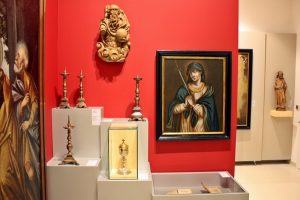 Beginnings of the Sacral Collection at the Diocesan Museum date back to the 1940s, when Kamilo Dočkal, canon of the cathedral chapter of Zagreb, initiated the collection of objects out of liturgical use in the parishes of the Zagreb Archbishopric based on a decision of Archbishop Alojzije Stepinac. On that occasion, a significant number of objects, mostly from the 18th and 19th centuries, were taken over from the parishes of present-day Požega Diocese and deposited at the Museum while remaining property of the parishes.
Beginnings of the Sacral Collection at the Diocesan Museum date back to the 1940s, when Kamilo Dočkal, canon of the cathedral chapter of Zagreb, initiated the collection of objects out of liturgical use in the parishes of the Zagreb Archbishopric based on a decision of Archbishop Alojzije Stepinac. On that occasion, a significant number of objects, mostly from the 18th and 19th centuries, were taken over from the parishes of present-day Požega Diocese and deposited at the Museum while remaining property of the parishes.
With the foundation of the Požega Bishopric, those objects passed into the care of the new local church, in accordance with the “Agreement on the Division of Common Property Following the Foundation of the Požega and Varaždin Bishoprics” (March 23, 2003), where Art. 5 states the following: “Objects of movable sacral heritage transferred to the newly founded Diocesan Museum in Zagreb from the episcopal territories of Požega and Varaždin, or deposited at the Museum before July 5, 1997, are to be returned to these bishoprics.” On the occasion of the Great Jubilee of 2000, the Požega Bishopric and the Municipal Museum of Požega organized in the latter venue an exhibition called “Tracing the Sacral Heritage of the Požega Bishopric”, with a catalogue of the same name, presenting a significant part of its sacral heritage from the Diocesan Museum in Zagreb, saved from devastation during World War II and the Croatian Liberation War. On the occasion of the third pastoral visitation of Pope John Paul II to Croatia in 2003, and the 150th anniversary of the Croatian-Slavonian ecclesiastical province, the Požega Bishopric and the Municipal Museum of Požega organized in the latter venue an exhibition called “Ignaz Berger – A Link between Art and Religion in the Požega Bishopric”, with a catalogue of the same name (2003). This exhibition presented a selection of paintings as precious witnesses to the religious life in the parishes of Voćin, Jasenovac, Gornji Bogićevci, Čaglić, and other places where church buildings had been completely or partly devastated in the Croatian Liberation War, together with their movable sacral property. These exhibits included the well preserved painting of Our Lady of Voćin, which the parish priest Josip Martinac had fortunately deposited at the Diocesan Museum of Zagreb in 1940. The collected remnants from Voćin were presented at the exhibition called “Fragments from Voćin’s Sacral Heritage”, held on the occasion of the renovation and consecration of the Voćin church and followed by a catalogue of the same name (2011) published in the series “Bibliotheca ars sacra posegana”.
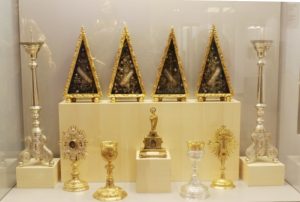 Parallel to the exhibition activity, the Bishopric initiated multiple collections of objects out of liturgical use in its parishes, which greatly enriched the holdings of Zagreb’s museum. Canon Dočkal carefully catalogued and documented all museum exhibits. This has been continued to the present day with newly acquired artefacts, now electronically and according to a special museum programme, whereby valuable assistance has been offered by experts from the Institute of Art History in Zagreb and members of the Commission for Sacral Heritage of the Požega Diocese, established in 2003. An important contribution to the organization of the Diocesan Museum has been offered by a project of the aforementioned institute led by Mirjana Repanić-Braun, aimed at assessing the current state of movable sacral heritage in the parishes of the Požega Diocese. The collected objects have been gradually and professionally restored and prepared for the permanent exhibition in their original splendour.
Parallel to the exhibition activity, the Bishopric initiated multiple collections of objects out of liturgical use in its parishes, which greatly enriched the holdings of Zagreb’s museum. Canon Dočkal carefully catalogued and documented all museum exhibits. This has been continued to the present day with newly acquired artefacts, now electronically and according to a special museum programme, whereby valuable assistance has been offered by experts from the Institute of Art History in Zagreb and members of the Commission for Sacral Heritage of the Požega Diocese, established in 2003. An important contribution to the organization of the Diocesan Museum has been offered by a project of the aforementioned institute led by Mirjana Repanić-Braun, aimed at assessing the current state of movable sacral heritage in the parishes of the Požega Diocese. The collected objects have been gradually and professionally restored and prepared for the permanent exhibition in their original splendour.
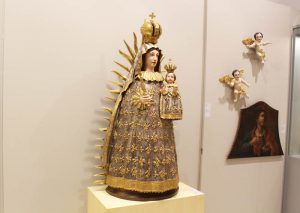 As mentioned before, the Požega Bishopric purchased an unfinished building in the cathedral square of St Theresa and entrusted it to architect Mario Beusan from the Faculty of Architecture at the University of Zagreb to adapt it for the permanent exhibition of the Diocesan Museum and the reading room of the Episcopal Library under the supervision of Ivica Žuljević, head of the Architectural Office of the Požega Diocese, and architect Irena Jurin from Zagreb, to be carried out by Presoflex, a construction company from Požega. The selection of sacral paintings and sculptures from the Museum’s holdings was made by Mirjana Repanić-Braun, that of metal objects by Arijana Koprčina, and that of liturgical vestments by Jelena Ivoš. Currently, around 200 artefacts from the sacral collection are exhibited in the permanent collection of the Museum.
As mentioned before, the Požega Bishopric purchased an unfinished building in the cathedral square of St Theresa and entrusted it to architect Mario Beusan from the Faculty of Architecture at the University of Zagreb to adapt it for the permanent exhibition of the Diocesan Museum and the reading room of the Episcopal Library under the supervision of Ivica Žuljević, head of the Architectural Office of the Požega Diocese, and architect Irena Jurin from Zagreb, to be carried out by Presoflex, a construction company from Požega. The selection of sacral paintings and sculptures from the Museum’s holdings was made by Mirjana Repanić-Braun, that of metal objects by Arijana Koprčina, and that of liturgical vestments by Jelena Ivoš. Currently, around 200 artefacts from the sacral collection are exhibited in the permanent collection of the Museum.
Collection of Modern and Contemporary Art
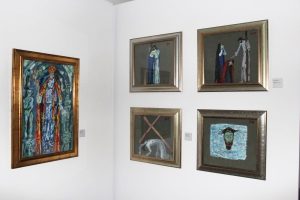 The Collection of Modern and Contemporary Art at the Diocesan Museum was created from the Gallery of the Požega Bishopric, with donations of paintings and sculptures made by individual artists. The largest donation has been that of painter Ivo Dulčić, made by his wife Miroslava, followed by those of Đuro Seder, Šime Vulas, Zlatko Keser, Josip Poljan, Šime Perić, Tihomir Lončar, don Vjeko Jaraka, and the Mostar-Duvanj Bishopric. The Collection of Modern and Contemporary Art has been further enriched by the collection of artworks owned by Bishop Antun Škvorčević, consisting mostly of gifts that he had received on the occasion of the Bishopric’s foundation and his episcopal ordination in 1997, as well as later, up to the present day. The museological concept and the exhibition design are work of Mario Beusan and the selection of some 200 items was made by Ivanka Reberski. During the preparation works around the Diocesan Museum, the Požega Bishopric organized several exhibitions with artworks from the museum holdings and loans from other proprietors, and published the catalogues “The Path of Light – Ivo Dulčić” (2008) and “Zlatko Šulentić – The Otherworldly and the Sacred” (2009) together with Matica Hrvatska Zagreb and Modern Gallery Zagreb. The Bishopric has recently published a monograph on Ivo Dulčić by Igor Zidić (2016) on the occasion of the 100th anniversary of the painter’s birth and organized a scholarly conference in the hall of the Diocesan Museum of Požega. With all these activities, the Bishopric seeks to promote the dialogue between religion and culture, which will be greatly facilitated by the permanent collection of the Diocesan Museum.
The Collection of Modern and Contemporary Art at the Diocesan Museum was created from the Gallery of the Požega Bishopric, with donations of paintings and sculptures made by individual artists. The largest donation has been that of painter Ivo Dulčić, made by his wife Miroslava, followed by those of Đuro Seder, Šime Vulas, Zlatko Keser, Josip Poljan, Šime Perić, Tihomir Lončar, don Vjeko Jaraka, and the Mostar-Duvanj Bishopric. The Collection of Modern and Contemporary Art has been further enriched by the collection of artworks owned by Bishop Antun Škvorčević, consisting mostly of gifts that he had received on the occasion of the Bishopric’s foundation and his episcopal ordination in 1997, as well as later, up to the present day. The museological concept and the exhibition design are work of Mario Beusan and the selection of some 200 items was made by Ivanka Reberski. During the preparation works around the Diocesan Museum, the Požega Bishopric organized several exhibitions with artworks from the museum holdings and loans from other proprietors, and published the catalogues “The Path of Light – Ivo Dulčić” (2008) and “Zlatko Šulentić – The Otherworldly and the Sacred” (2009) together with Matica Hrvatska Zagreb and Modern Gallery Zagreb. The Bishopric has recently published a monograph on Ivo Dulčić by Igor Zidić (2016) on the occasion of the 100th anniversary of the painter’s birth and organized a scholarly conference in the hall of the Diocesan Museum of Požega. With all these activities, the Bishopric seeks to promote the dialogue between religion and culture, which will be greatly facilitated by the permanent collection of the Diocesan Museum.


